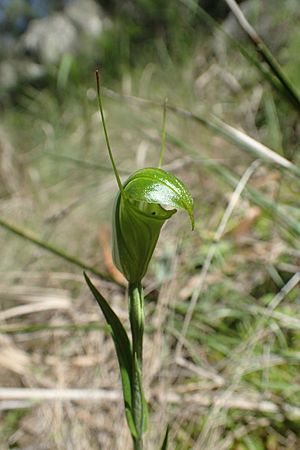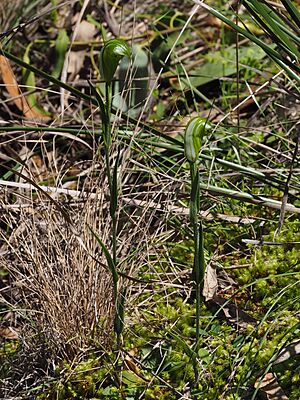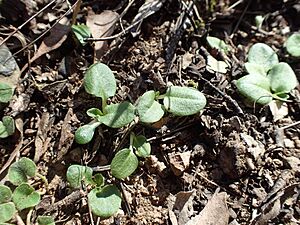Blunt-tongue greenhood facts for kids
Quick facts for kids Blunt-tongue greenhood |
|
|---|---|
 |
|
| Pterostylis obtusa growing near Gara Gorge | |
| Scientific classification | |
| Genus: |
Pterostylis
|
| Species: |
obtusa
|
| Synonyms | |
|
Diplodium obtusum (R.Br.) D.L.Jones & M.A.Clem. |
|
The Pterostylis obtusa, often called the blunt-tongue greenhood, is a special type of orchid. It grows only in New South Wales, Australia. You can tell it apart from other greenhood orchids by its thick, flat, platform-like part called a sinus. Its labellum (a special petal) is blunt and just barely peeks out above the sinus.
Contents
What Does the Blunt-Tongue Greenhood Look Like?
The blunt-tongue greenhood has a group of leaves called a rosette. This rosette usually has three to six dark green, egg-shaped leaves. Each leaf is about 12 to 25 millimeters (about 0.5 to 1 inch) long and 10 to 15 millimeters (about 0.4 to 0.6 inches) wide. They often look a bit crinkled.
The Flower Spike and Its Features
A single, shiny, bright green and white flower grows on a tall stem called a flowering spike. This spike can be about 150 to 250 millimeters (about 6 to 10 inches) tall. The spike also has three to five smaller leaves on its stem.
The flowers themselves are about 20 to 28 millimeters (about 0.8 to 1.1 inches) long and 10 to 12 millimeters (about 0.4 to 0.5 inches) wide.
Key Parts of the Flower
- The top part, called the dorsal sepal, curves forward. It has a thin, thread-like tip about 4 millimeters (about 0.16 inches) long.
- The edges of the petals are flared, meaning they spread out.
- The sinus, which is a flat, platform-like part, has a rolled edge.
- The lateral sepals (the side parts) have long, thread-like tips that are about 20 to 26 millimeters (about 0.8 to 1 inch) long.
- The labellum, which is the "blunt tongue," is about 9 to 11 millimeters (about 0.35 to 0.43 inches) long and 3 millimeters (about 0.12 inches) wide. It's green and, as its name suggests, blunt at the end. You can just see it above the sinus.
This orchid usually blooms between February and June.
Where Does This Orchid Grow?
The blunt-tongue greenhood likes to grow in moist areas, often among grass. You can find it in the ranges and tablelands of New South Wales. It also grows on Lord Howe Island, which is a small island off the coast of Australia.
It's important to know that similar orchids found in Tasmania are actually a different species called Pterostylis atrans.
How Did It Get Its Name?
The blunt-tongue greenhood, Pterostylis obtusa, was first officially described in 1810 by a botanist named Robert Brown. He published his description in a book called Prodromus Florae Novae Hollandiae et Insulae Van Diemen.
The second part of its scientific name, obtusa, comes from a Latin word. It means "blunt" or "dull," which perfectly describes the blunt shape of its labellum!



